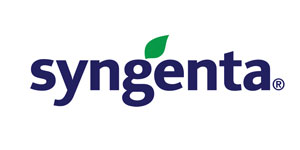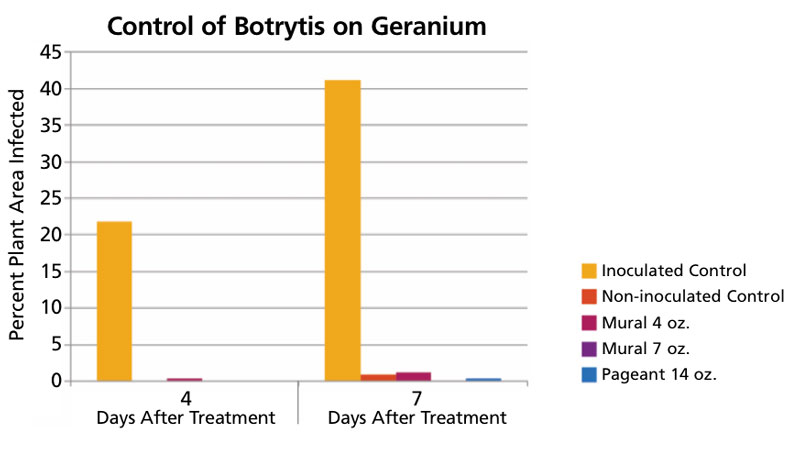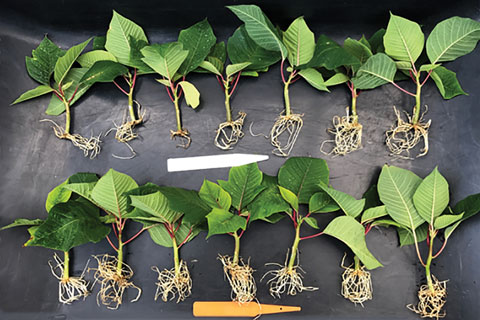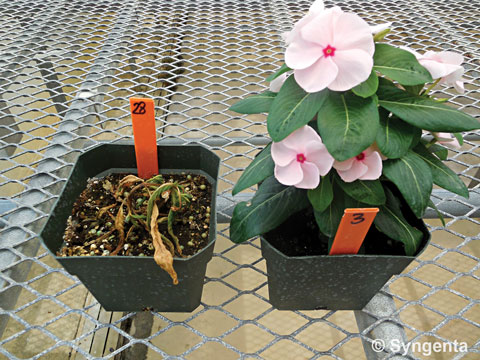9/1/2018
Protection from Propagation to Finish
Nancy Rechcigl

As you evaluate the best fungicides for your plants during propagation, you’ll likely notice that, in addition to disease control, some products offer plant health benefits for your crops, which is important for strong rooting and plant growth. Understanding the science behind these fungicides is important to determine whether these benefits will be seen in your operation. One key factor is the rate at which the product can be applied. The higher it is, the less likely it will affect plant health.
It’s not recommended to apply fungicides solely for plant health, but they can be an added benefit if the right product is chosen and applied appropriately. Propagation is the ideal time to begin preventive fungicide programs to limit disease spread and help enhance plant health.
Plants in propagation can be at risk of developing various diseases, including foliar blights caused by Botrytis cinerea, leaf spots caused by Alternaria, Colletotrichum and Myrothecium spp., as well as lower stem rots. Young seedlings are also at risk of damping-off from Pythium, Phytophthora and Rhizoctonia spp. when the growing media is wet for a prolonged period of time.
The warm, humid environment during propagation can provide optimal conditions for spores of pathogenic agents to germinate and invade wounds and tender plant tissue. It’s crucial to identify diseases early. Proper cultural practices and preventive fungicide applications can help growers keep a successful crop throughout production, and also provide plant health benefits for stronger roots and fuller growth. If preventive strategies aren’t put in place, growers may have to resort to curative applications, which are costly and not as successful.

Start strong, stay protected
Mural fungicide is a broad-spectrum option for greenhouse and nursery growers to combat destructive diseases during propagation. It’s labeled to control more than 50 ornamental diseases, including Botrytis, leaf spots, rusts, powdery mildew and many soil-borne diseases. Mural offers the flexibility for use as a spray or a drench, providing effective disease protection in propagation and after transplant. It has also demonstrated plant health benefits in ornamental crops.
Resistance can be a concern when it comes to fungicides. Rotating modes of action has become more important than ever to treat diseases. With two active ingredients in FRAC groups 7 and 11, Mural is ideal for incorporating into rotation programs for protection against a wide variety of pathogens.
One of the two active ingredients in Mural, Solatenol fungicide, is an advanced generation SDHI (succinate dehydrogenase inhibitor) that binds to the waxy layer of plants and slowly penetrates the tissue, creating a barrier of protection. Mural inhibits spore germination and mycelial growth, providing plant protection inside and out.
 Pictured: Non-treated control (top) and Mural 4-oz. spray (bottom).
Pictured: Non-treated control (top) and Mural 4-oz. spray (bottom).
Mural also contains azoxystrobin from the strobilurin class of chemistry, which is systemic and offers xylem mobile movement, meaning it’s absorbed by the plant and translocated upward to protect new growth.
In addition to its fungicide activity, azoxystrobin affects physiological processes within plants that result in plant health benefits. It has been shown to:
• Lower rates of transpiration in plants, maximizing the efficiency of water use.
• Reduce ethylene production, which helps delay senescence so leaves stay greener longer, resulting in more efficient photosynthesis. This results in increased production of carbohydrates within the plant, which improves growth and plant vigor.
• Increase nitrate reductase levels in plants, which allows nitrates to be more readily available for the production of proteins essential to plant growth.
Plant health effects, such as root enhancement, are more often seen at lower use rates with strobilurin chemistries. The higher the use rate, the less likely root benefits will be observed. Mural is labeled at a rate of 4 oz. for foliar and 2 to 3 oz. for drench applications. At these low rates, it provides broad-spectrum disease control and offers plant health benefits, like increased root density.
Improved root development has been observed when Mural is applied as a drench to protect plants from root and stem diseases caused by Rhizoctonia solani, Sclerotium rolfsii and Pythium spp. These benefits are due to positive effects on plant physiology, which can vary according to plant species and growing environment.
 Pictured: Control of Rhizoctonia. Untreated (left) and Mural 2-oz. drench (right).
Pictured: Control of Rhizoctonia. Untreated (left) and Mural 2-oz. drench (right).
Recent trials conducted at Ohio State and Michigan State Universities have shown that Mural is providing effective protection against black root rot (Thielaviopsis basicola), which can affect a wide range of annual and perennial crops. Plant development and quality are severely reduced once this pathogen invades and establishes in a root system that is left unprotected. Additional trials are being conducted to further assess the activity of Mural on this pathogen.
By applying a fungicide drench of Mural during propagation, you can help prevent the onset of diseases, while also experiencing the plant health benefits of its strobilurin chemistry. Mural is labeled for use in greenhouse and nurseries and can be applied to vegetable transplants grown for resale to consumers. Its broad-spectrum activity and two active ingredients make it a powerful option for fungicide rotation programs to help keep crops clean.
Learn more at www.GreenCastOnline.com/PlantHealth. GT
Nancy Rechcigl is Technical Services Manager for Syngenta.
Syngenta does not recommend or endorse making applications solely for physiological benefits or using reduced rates (lower than labeled) for physiological effects. Performance assessments are based upon results or analysis of public information, field observations and/or internal Syngenta evaluations. Trials reflect treatment rates commonly recommended in the marketplace.